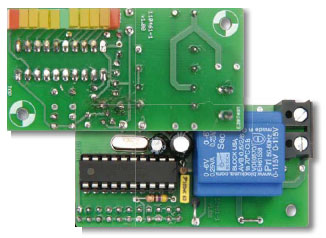Article
Grid Frequency Monitor: Tiny Fluctuations Evidenced by LEDs

Measuring the AC powerline frequency is a proxy for determining the match between the supply of and demand for power in the national grid and therefore an important indicator of the status of the AC line supply. This monitoring device detects tiny deviations in frequency with a range of just ±0.2 Hz, allowing you to keep an eye on the load on the grid from any convenient socket.
Materials
Gerber file
CAM/CAD data for the PCB referred to in this article is available as a Gerber file. Elektor GREEN and GOLD members can exclusively download these files for free as part of their membership. Gerber files allow a PCB to be produced on an appropriate device available locally, or through an online PCB manufacturing service.
Elektor recommends the Elektor PCB Service service from its business partner Eurocircuits or AISLER as the best services for its own prototypes and volume production.
The use of our Gerber files is provided under a modified Creative Commons license. Creative Commons offers authors, scientists, educators and other creatives the freedom to handle their copyright in a more free way without losing their ownership.
PCB
Extra info / Update
* Display range 49.8 Hz to 50.2 Hz (50 Hz firmware version)
* Display range 59.8 Hz to 60.2 Hz (60 Hz firmware version)
* Accuracy ±0.0025 Hz
* LED readout with 11 LEDs
* No calibration required
* No SMD components
* Low component count
* Suitable for 230 V and 115 V operation
* Display range 59.8 Hz to 60.2 Hz (60 Hz firmware version)
* Accuracy ±0.0025 Hz
* LED readout with 11 LEDs
* No calibration required
* No SMD components
* Low component count
* Suitable for 230 V and 115 V operation
Component list
Resistors
R1 = 470Ohm
R2,R3 = 10kOhm
Capacitors
C1 = 100nF MKT, 5mm pitch
C2,C3 = 56pF ceramic, 2.5mm pitch
C4 = 100?F 25V, radial, 2.5mm pitch
C5,C6 = 10?F 16V, radial, 2.5mm pitch
Semiconductors
D1,D2 = 1N4007
IC1 = AT89C2051-24PU (Atmel), programmed, Elektor # 110461-41 (50Hz) or 110461-42 (60Hz)
IC2 = LM2936Z-5.0
LED1, LED11 = LED, red, low-current, 5x2 mm
LED2,LED3,LED4,LED5,LED7,LED8,LED9,LED10 = LED, yellow, low-current, 5x2 mm
LED6 = LED, green, low-current, 5x2 mm
Miscellaneous
K1 = 2-way PCB terminal block, 7.5mm pitch
J1,J2,J3 = 2-pin pinheader, 5mm pitch, with jumper (or wire link), see text
TR1 = AC power transformer, 0.5VA, 2x115V primary, 2x6V secondary, e.g. Block type AVB0,5/2/6)
X1 = 12MHz quartz crystal, HC-49S case
AC adapter case, ABS, approved, to suit local power outlet.
R1 = 470Ohm
R2,R3 = 10kOhm
Capacitors
C1 = 100nF MKT, 5mm pitch
C2,C3 = 56pF ceramic, 2.5mm pitch
C4 = 100?F 25V, radial, 2.5mm pitch
C5,C6 = 10?F 16V, radial, 2.5mm pitch
Semiconductors
D1,D2 = 1N4007
IC1 = AT89C2051-24PU (Atmel), programmed, Elektor # 110461-41 (50Hz) or 110461-42 (60Hz)
IC2 = LM2936Z-5.0
LED1, LED11 = LED, red, low-current, 5x2 mm
LED2,LED3,LED4,LED5,LED7,LED8,LED9,LED10 = LED, yellow, low-current, 5x2 mm
LED6 = LED, green, low-current, 5x2 mm
Miscellaneous
K1 = 2-way PCB terminal block, 7.5mm pitch
J1,J2,J3 = 2-pin pinheader, 5mm pitch, with jumper (or wire link), see text
TR1 = AC power transformer, 0.5VA, 2x115V primary, 2x6V secondary, e.g. Block type AVB0,5/2/6)
X1 = 12MHz quartz crystal, HC-49S case
AC adapter case, ABS, approved, to suit local power outlet.


Discussion (0 comments)